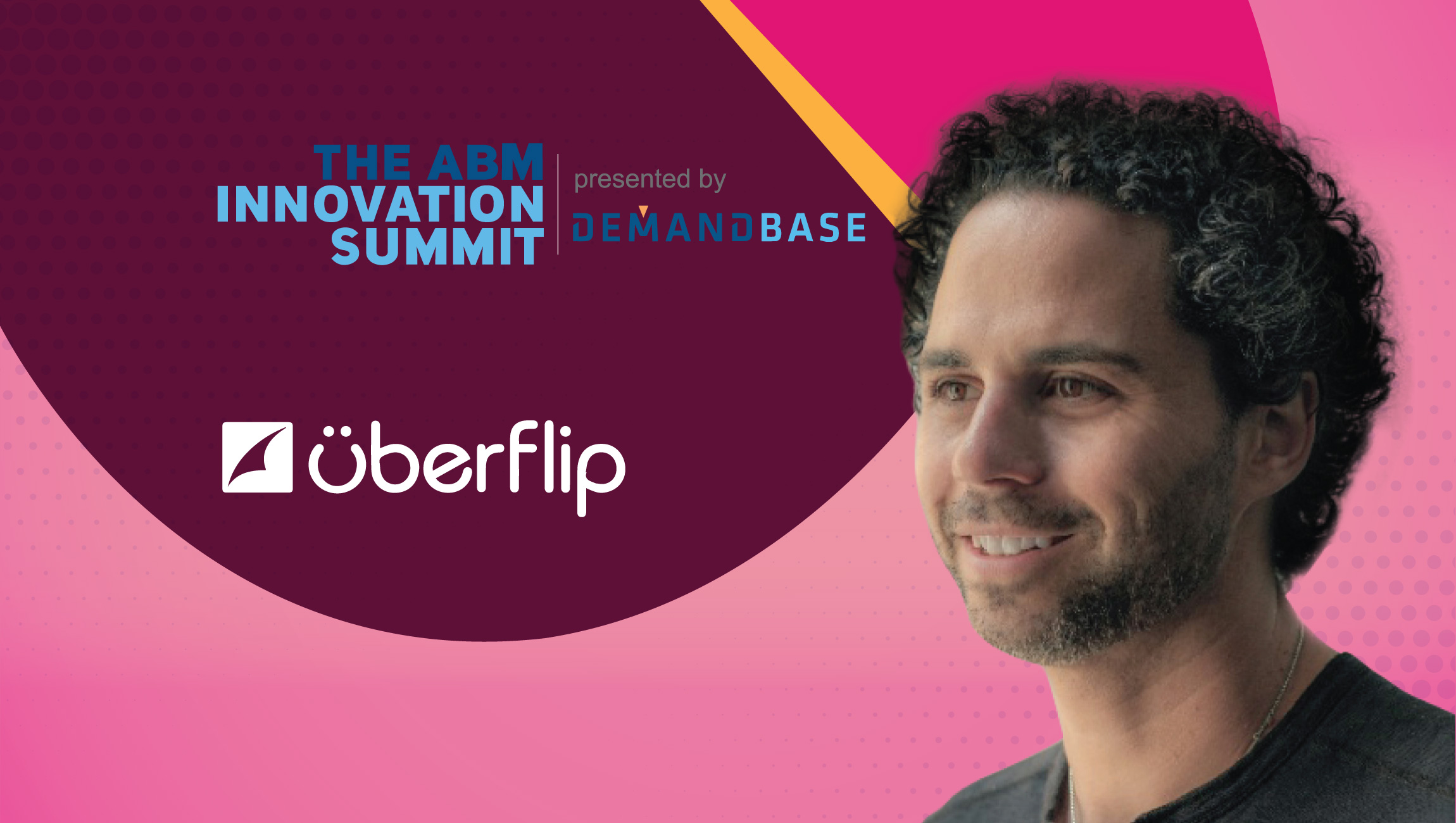Tell us about your vision for ABM and the role it plays in the current Marketing-Sales alignment.
Talking vision in ABM these days is tricky; where do you begin with something so hot and so new? I think of ABM in a very simple way: what are the accounts that we want to win and how are we going to win them as an organization? Historically, a lot of us thought that marketing should be responsible for simply finding accounts and then sales should be responsible for closing those accounts. The vision of ABM is really bringing those two groups united around the idea of winning the account together. That means that marketing’s role does not end at MQL. At the same time, sales doesn’t start by just taking a list and targeting those accounts.
ABM requires multiple steps to be done properly. It starts with identifying key accounts, thinking about tiering accounts and setting up the accounts that we can expand on and predict on. The real aspect of executing properly is getting beyond just account identification and focusing on account engagement, i.e. what are we going to do to actually engage that account? One of my favorite movies is “Field of Dreams.” And there’s a great line: “If you build it, they will come.” That’s not what happens in marketing. If we choose the accounts, they’re not simply going to flow in. We need to support teams on both sides so that we win those accounts.
How does a B2B event such as ABM Innovation Summit 2019 benefit the full funnel Sales & Marketing practices? Why should one attend the event?
Demandbase has done an amazing job at championing ABM from the early stages. What I love about their approach is it’s not just about what Demandbase does, it is about the ecosystem that comes together to solve for ABM. I like to think that any solution comes down to the right people, the right process, and the right technology. Demandbase’s ABM Innovation Summit brings together great people with amazing thought leadership, and with excellent technology providers being brought forward as well. Every one of them brings new processes that we can figure out how to scale with success.
What lessons can a Content Marketing team learn from attending ABM Innovation Summit 2019?
Content Marketing teams now need to shift their understanding of what do they need to do to support their organization. In the inbound days, content marketers simply had to create top funnel content that would attract an audience to make an inquiry. From there, they’d talk to their sales team and then the responsibility more or less stopped there. The reality with ABM is marketing understanding their role at every stage, from top of funnel and progressing through the sales funnel.
That’s not just with ABM; that should apply to inbound and other strategies, but more than ever with ABM we’re seeing marketing responsible at every stage. Content marketers must understand the ways they can influence different stages of a pipeline, which will give them the perspective to the different forms and types of content that will help accelerate a deal.
What are the key pillars of Content Marketing experience in 2019? To what extent can this experience-driven operation be automated?
In 2019, organizations are really turning their attention to content experience. In fact, the end of 2018 was the first time the G2 Crowd recognized content experience as a separate category from Content Marketing. That’s because creating content should not be the end; the way people experience and encounter content is perhaps even more important than the content we put forward. That has to do with how we organize content, how we structure content, and how we compel people to engage. However, the tricky part is doing this at scale.
We may acknowledge and say content experience is important: the way it looks, the way it‘s structured, the way it convinces us to convert. But how do we do this time and time again? That’s where the Content Experience Framework comes into play. It’s five steps that help us understand how to put out experiences at scale. The first step is to centralize your content, the second step is to organize your content, the third is to personalize your content, the fourth is to distribute your content, and the fifth step is to generate results. If you want to see more about how this content experience framework comes to play and comes to light, go to uberflip.com/ce or to b-rand.com to get my book.
Become a ‘Wow’ Marketer: 5 Marketing Technology Events You Can’t Miss This Season
What are the opportunities and risks you foresee in the way user-generated content is shaping ABM and the B2B data management landscape for 2020-25? How do Uberflip and ABM Innovation Summit prepare customers for these disruptions?
User-generated content is truly changing the way we think about content creation. We’ve gone away from the days of polished, perfect content to the idea that people are looking for short snippets of content. For example, I will post a video and share a piece of content on LinkedIn multiple times a week. Those videos I post get anywhere from a few hundred to tens of thousands of views and likes on a case-by-case basis. The reality is, all of us are strapped for time so the way we hook someone in is sometimes a more short, digestible piece of content. We can also use those strategies to think about scale.
If we create more meaningful bits of content for the accounts we’re engaging, created either by our marketing teams or by our sales teams, we may be able to hook the audience we are trying to sell to. A platform such as Vidyard, for example, is a great solution that allows your sales team to actually engage accounts by creating their own sales video that walks through how they can add value. Enabling our organizations to create video for ABM on a case-by-case basis will be something that will continue to be important as the expectations for personalization rises.
How does Uberflip allow you to personalize content experiences at scale? What analytics, tools, and techniques do you provide to measure the success of automation-driven campaigns?
This starts with understanding what your audience cares about and we can do this in a number of ways. If the audience you’re trying to engage with already has engagement with you, then you’ll simply be able to use those engagement metrics that are passed over to your Marketing Automation platform. If you’re using a platform such as Eloqua or Marketo, Uberflip passes engagement and content over so that you can leverage that to determine what piece of content to deliver next.
At the same time, some of us are engaging with an audience for the first time with no first-party data. In that case, we can use third-party data. Uberflip has a very meaningful relationship with a company called Bombora. Bombora serves third-party data that allows us to match the right content to your audience, even if it’s that first date. As such, we can start to predict the right content to greet someone before we are able to deliver a more truly personalized experience.
How much has the MarTech around ABM platforms evolved with the maturity of Data Management and Sales Intelligence tools?
Our audiences, more than ever, expect a personalized experience. This comes from many of the consumer experiences that we engage with on a daily basis. We go to Netflix because they know what video to serve next to us. We open up Spotify because they curate music that is literally made for us. The expectations in our consumer lives, without a doubt, impact the expectations in our business-to-business lives. That’s where ABM platforms are evolving to ensure that data can be used to deliver the right content or the right messaging to the right audience.
A great example is Demandbase, which is sitting with a wealth of knowledge about our audience. We have the ability to leverage that data and use it through integrations into other ABM platforms, whether it’s a content platform such as Uberflip, or whether its something like Sigstr where we can automate the type of signature that we put in an email, for example. The key is leveraging the data to ensure that we deliver the same personalized experiences that those companies such as Netflix and Spotify are doing to win over their audience.
What’s your prediction on the MarTech ecosystem witnessing all the innovations around automation in AI?
Over the last year, I think there’s been a bit of a reality check on AI. As marketers, we don’t need AI platforms. Rather, we need AI to be merged into the other MarTech platforms that we use. AI is simply our ability to handle large data sets and make use of them to make business decisions. Whether you’re using a Marketing Automation platform, a platform such as Demandbase or Uberflip, you should be able to make those decisions and scale. That’s why you see companies, like ours, who have invested significantly in data science teams. Data science is our ability to handle that data, both in terms of how we build our products and how we help our customers make their day-to-day decisions.
Tell us about the ABM roadmap you have at Uberflip for the AMB community in 2019/2020. Which technology providers could better leverage your products?
2018 was a big year for ABM at Uberflip. Our approach and vision is to enable the various ways that a marketer goes to market. That meant, when it came to ABM, we weren’t going to change our platform into an ABM platform because ABM is just one strategy. However, we made adjustments to our platform to ensure that our customers could build what we refer to as ABM stream, which is essentially a subset of a marketing stream. Moving into 2019 and 2020, we go from creating engaging experiences to being able to measure what’s working.
At Uberflip, we’ve been investing a lot around our metrics platform and understanding what content and what different engagement strategies lead to higher engagement among accounts. Leveraging Marketing Automation platforms is a part of that, but having data inside of our own platform will allow marketers to determine what content to create and ultimately how to engage their accounts in more meaningful ways.
Thank you for answering all our questions!
Randy Frisch is the CMO and Co-Founder at Uberflip, a content experience platform that empowers B2B marketers to create personalized content experiences for demand generation, ABM, content marketing, and sales enablement at scale.
We believe content is the most effective way to ignite meaningful relationships. But even the greatest content must be combined with a remarkable experience to reach its full potential. Uberflip is a cloud-based content experience platform that empowers B2B marketers to create personalized content experiences at scale. By providing marketers with the tools they need to boost engagement, generate leads, and fuel demand generation, they can better leverage content to meet their goals.












